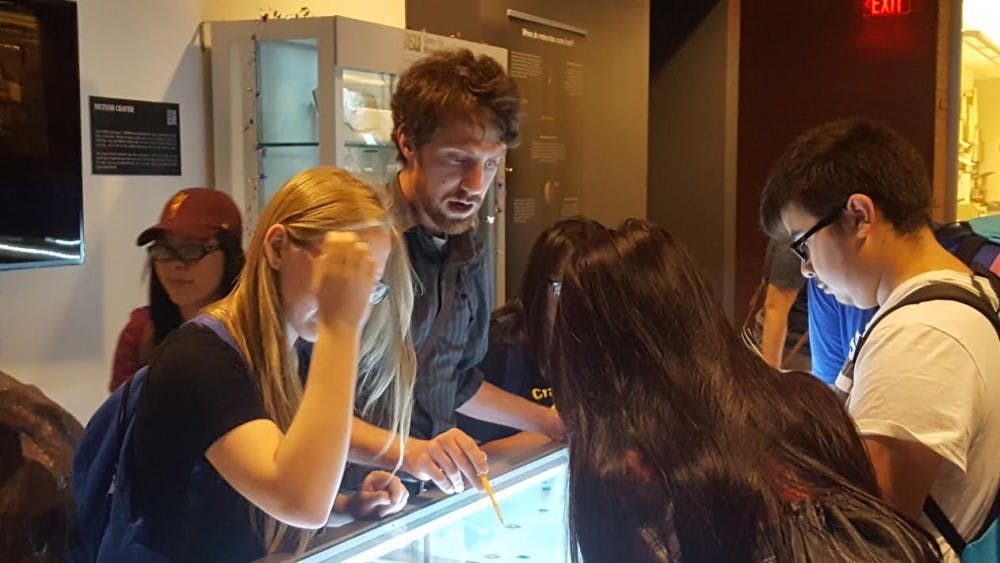ASU’s School of Earth and Space Exploration does more than teach about the final frontier. It is also the home to numerous researchers actively studying space that have had a hand in placing objects all throughout the solar system.
From objects orbiting the moon to objects on the surface of Mars, the school has a robust history of space exploration and displays that history throughout the Tempe campus in numerous galleries, all open to the public.
Gallery of Scientific Exploration
Located on the first two floors of ISTB 4 on Tempe campus, the Gallery of Scientific Exploration acts as a showcase for ASU’s scientific research.
Ric Alling, manager of the Marston Exploration Theater, a planetarium housed within the gallery, said that the gallery acts as public outreach for SESE.
“I think of it more like a visitors center instead of a general science museum,” Alling said. “I think what we’re trying to do is focus the exhibitry here on specifically things that ASU has a lot of working relationships with.”
The Marston Theater inside of the gallery offers views of the universe in 3D twice a week on Wednesdays and Saturdays. It uses 4K projectors to give patrons a look around our galactic neighborhood and beyond.
“In that spirit of exploration, especially planetary studies, we use that theater in the unique 3D stereographic environment to just take people on journeys,” Alling said. “We take people to places and talk about the science going on there.”
Outside of the theater, the gallery hosts an ever changing repertoire of examples of ASU’s scientific research. Alling said that the gallery keeps up with new discoveries and research missions made or assisted by ASU, which keeps the content fresh.
“You can go to a museum and find exhibits that have been there for 40 years,” Alling said. “That shouldn’t happen here because we’re always kind of keeping pace with what researchers are doing right now.”
LROC Science Operations Center Visitor Gallery
The Lunar Reconnaissance Orbiter Camera, or LROC for short, is a three camera system mounted on the Lunar Reconnaissance Orbiter, a robotic spacecraft that is currently orbiting the moon. The camera takes photographs of the moon’s surface and sends them back to scientists.
LROC’s visitor gallery, housed on the first floor of the Interdisciplinary A-Wing, gives visitors an overview of lunar exploration as a whole as well as the LROC from 9:30 a.m. to 4:30 p.m. on weekdays.
The gallery takes a look at the history of lunar exploration, with displays on past missions to the moon undertaken by various nations.
Laura Davis, LROC’s multimedia technician, said that the LRO is, of course, the main focus of the gallery.
“The main focus of what we do is seeing what LRO does in our images because they’re gorgeous in my personal opinion,” Davis said. “They’re just spectacular to look at.”
Housed in the gallery among other displays pertaining to lunar travel is an actual rock from the moon. Visitors can also watch images of the moon as they are received from the LRO.
Davis said that the images visitors can see are brand new, displayed as they come in. This means that visitors will likely see a part of the surface of the moon that no one has ever seen before.
“They normally take a few days to get between the spacecraft and here,” Davis said while watching an image of the moon’s surface render itself onto the screen in front of her. “That is pretty much the first time anybody has seen this image of the moon, and because of the sheer amount of data that we collect, it’s likely that no one will ever look at it again.”
Mars Space Flight Facility Gallery
The visitors gallery for the Mars Space Flight Facility, located on the first floor of the Moeur building and open from 8 a.m. to 5 p.m., gives patrons a chance to see models of the instruments used by scientists in researching the Martian planet.
Visitors to the gallery are greeted at the front by the sight of a life size model of one of the Mars rovers.
Jonathon Hill, a Mission Planner for the Mars Space Flight Facility, said that the models are of tools created at ASU.
“When you’re in the front lobby, we have a model of the Mars rovers from 2003 that ASU had two instruments on,” Hill said. “In the inner lobby we have models of the instruments we’ve built. You can actually see what the instruments look like.”
Like the LROC gallery, Hill said that visitors can also see data collected in real time as well.
“We have windows where you can see the two labs that we have in our building where we’re actually analyzing the data and kind of processing it.
Hill added that the gallery is a complete overview of ASU’s part in the Mars rovers.
“You get sort of a summary of the entire mission,” Hill said.
Reach the reporter at jdarge@asu.edu or follow @jeffdarge on Twitter.
Like The State Press on Facebook and follow @statepress on Twitter.




